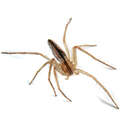en
names in breadcrumbs


The spider family Philodromidae (running crab spiders) includes 542 described species, nearly a hundred of which are known from North America north of Mexico (Philodromus dispar is native to Europe and Central Asia, but has been introduced to the United States and Canada) (Platnick 2013).
Philodromids are two-clawed, flat-bodied, somewhat crab-like hunting spiders (Dondale 2005). Like thomisids, many species hold their legs in a laterigrade position (i.e., the legs extend sidewise and the femora, especially, are twisted so that the front surface faces up). The eight eyes are at the front of a narrow cephalic region (i.e., the forward part, or "head" region, of the cephalothorax) and the cephalothorax is broad and often as wide as it is long. These spiders were formerly considered to comprise a subfamily of Thomisidae, but Homann (1975, cited in Dondale 2005) concluded that they were independent of the thomisids, a finding confirmed by the molecular phylogenetic analysis by Benjamin et al. (2008). In comparison with philodromids, thomisids tend to have more compact and globose bodies, with thicker legs; raptorial spines on the first pair of legs; prominent eye tubercles ("bumps"); and no claw tufts or scopulae, or distinct brushes of hair, on their legs.
Philodromids lead an active predatory lifestyle on plant stems and leaves. Some are found only on coniferous trees, others only on deciduous trees; a small number live in deserts. Life histories have been studied by Dondale (1961) and Putnam (1967) and Haynes and Sisojevic (1966) studied predatory behavior. Dondale (1964, 1967) used courtship behavior to distinguish some closely related species.
(Dondale 2005; Bradley 2013)